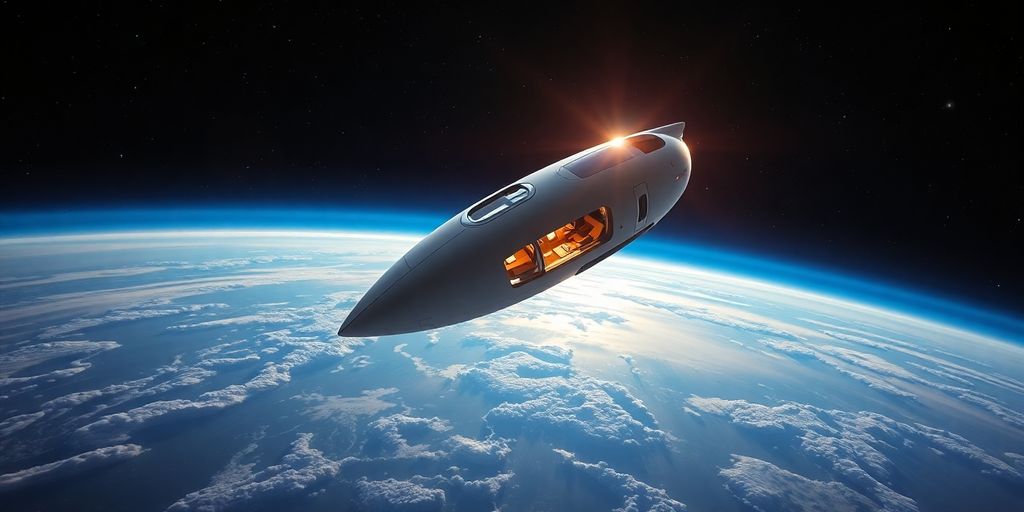The space tourism industry is booming, especially among the ultra-wealthy. With advancements in technology and increasing interest from private companies, traveling to space is becoming a reality for those who can afford it. This article explores the latest trends in space tourism, highlighting the companies and technologies that are shaping this exciting new frontier.
Key Takeaways
- Space tourism is rapidly growing, with a market expected to exceed $13 billion by 2030.
- Companies like Blue Origin and SpaceX are leading the charge, offering unique experiences for high-paying customers.
- Suborbital flights are currently the most popular option, with prices ranging from $200,000 to $300,000.
- Emerging players are focusing on eco-friendly technologies to attract environmentally conscious travelers.
- Luxury space hotels and long-duration stays are set to become significant offerings in the space tourism market.
1. Blue Origin

Blue Origin is definitely making waves in the space tourism scene. It’s hard to ignore Jeff Bezos’ company when talking about the future of space travel. They’re aiming to make space more accessible, and that’s a pretty big deal.
Blue Origin offers suborbital flights that give passengers a taste of weightlessness and some amazing views of Earth. These flights go above the Kármán Line, which is considered the edge of space. While it’s a short trip, it’s still a trip to space!
Blue Origin’s approach focuses on reusable rockets, which could bring down the cost of space travel in the long run. This is a key factor in making space tourism more than just a luxury for the ultra-rich.
Here’s a quick rundown of what Blue Origin is bringing to the table:
- Suborbital flights to experience weightlessness.
- Reusable rocket technology for cost efficiency.
- A focus on safety and reliability.
Blue Origin’s tickets are in the $200,000 to $300,000 range, which puts them in the "expensive, but not insanely expensive" category. They’ve already flown dozens of people, and they’re planning to ramp up their flight schedule. It’s exciting to see where they go next. In March 2024, Blue Origin showed its Blue Ring spacecraft’s operational capabilities during the Defense Innovation Unit’s DarkSky-1 mission, confirming flight systems and in-space processing.
2. SpaceX
SpaceX, spearheaded by Elon Musk, is setting its sights on long-duration orbital missions. Forget a quick hop; they’re talking days or even weeks in space. This isn’t your average vacation; it requires some serious training to handle the effects of prolonged weightlessness.
SpaceX’s reusable rocket tech, like the Falcon 9 and Falcon Heavy, is a game-changer. It offers a more cost-effective and sustainable way to get to space, which could open up space tourism to a wider audience.
SpaceX has already made waves by making its Crew Dragon spacecraft available for chartered orbital missions. Remember Inspiration4? That mission sent four private citizens into orbit for three whole days. Plus, they’ve been working with Axiom Space, sending astronauts and tourists to the International Space Station for private missions. This is a big deal for commercial space travel.
Here’s a quick look at some key SpaceX missions:
- Inspiration4: First all-civilian mission to orbit.
- Axiom Missions: Transporting private astronauts to the ISS.
- Future Plans: Aiming for even longer orbital stays.
SpaceX’s approach is about more than just a quick trip; it’s about pushing the boundaries of what’s possible in space travel. They’re not just offering a ride; they’re offering an experience. They are also working on bespoke island-hopping experiences for the ultra-wealthy.
And let’s not forget the environmental aspect. SpaceX’s reusable rockets are a step towards more eco-friendly space travel, which is becoming increasingly important. They are also planning to offer exclusive access to local festivals in space.
3. Virgin Galactic
Virgin Galactic is making waves in the space tourism sector, aiming to provide suborbital flights to those eager to experience the wonders of space. They’ve been working hard to make space travel a reality for private citizens, and it’s pretty exciting to see how far they’ve come.
Virgin Galactic sent test passenger Beth Moses into space in February 2019, which was a big step. The spaceship, designed to carry six passengers and two pilots, has tickets priced around $250,000 each. That’s a hefty price tag, but for a trip to space, it might just be worth it for some. UBS polled over 6,000 high-net-worth people on flying with Virgin Galactic. Approximately 20% of respondents polled by UBS stated they are "likely to purchase a ticket on a spaceship within 1 year" of the firm starting regular flights. This figure rises to more than 35% "after several years of safe operation," according to UBS.
Here’s what makes Virgin Galactic stand out:
- Focus on suborbital flights: These flights offer a taste of space without the extensive training required for orbital missions.
- Relatively lower cost (compared to orbital flights): While still expensive, their tickets are more accessible than those for trips to the International Space Station.
- Experience: They’ve been in the game for a while, working towards making space tourism a reality.
Virgin Galactic’s approach focuses on the experience of getting to space, offering a unique perspective on our planet. It’s not just about the destination, but the journey itself, and the feeling of weightlessness and seeing Earth from above.
It’s interesting to see how Virgin Galactic is shaping the future of space tourism, making it a bit more within reach for those who dream of touching the stars. They are one of the key players in the space tourism market, along with Zero 2 Infinity. They offer recreational space voyages for those who can afford it. The company’s VSS Unity offers suborbital space journeys from New Mexico.
4. Orion Span
Orion Span, a U.S.-based company, had some pretty big plans. They wanted to launch a private commercial space station, called the Aurora Space Station, into Low Earth Orbit (LEO). The idea? To use it as a space hotel that could host up to six people at a time. It was a bold vision for luxury travel, letting people spend extended periods in space.
Unfortunately, Orion Span seems to have faded from the scene. Their website is down, and there haven’t been any recent updates about the Aurora Space Station. It’s a bummer, but the dream of space hotels is still alive, with other companies picking up the torch.
While Orion Span’s specific project might not be happening, the concept of space hotels is definitely a trend to watch. It shows how the space tourism industry is aiming for more than just quick trips to the edge of space. Companies are thinking about long-duration orbital stays and how to make them comfortable and appealing to the ultra-wealthy. Imagine spending weeks or even months in space, enjoying all the amenities of a luxury hotel while orbiting Earth! That’s the kind of experience that could really drive the space travel market forward. It’s all about creating unique experiences that will boost their brand image and innovation efforts.
Here’s a quick look at what Orion Span was aiming for:
- Luxury accommodations in space
- Extended stays in orbit
- A unique and exclusive travel experience
- Contributing to the growth of the space tourism industry
Even though Orion Span’s Aurora Space Station might not be taking off, their vision has helped shape the future of space tourism. The idea of renting private castles in space is still very much in play, and other companies are working hard to make it a reality. The future of space tourism is looking bright, even if some of the early pioneers have faced challenges.
5. Space Perspective
Space Perspective is taking a different approach to space tourism, focusing on stratospheric ballooning. Instead of rockets, they use a high-altitude balloon to lift a pressurized capsule, called Spaceship Neptune, to the edge of space. It’s a gentler, more relaxed experience, offering stunning views of Earth without the intense G-forces of a rocket launch. I think it’s a pretty cool idea, and definitely something different than what the other companies are doing.
The company aims to provide a comfortable and accessible space tourism experience, emphasizing the panoramic views and the unique perspective of seeing Earth from the stratosphere. It’s less about the thrill of speed and more about the wonder of the view.
Here’s what makes Space Perspective stand out:
- Gentle Ascent: No intense acceleration or weightlessness.
- Panoramic Views: Large windows for unobstructed views of Earth.
- Luxury Experience: A comfortable, pressurized capsule with amenities.
Space Perspective is targeting a different market segment than the rocket-based space tourism companies. They’re aiming for people who want to experience the beauty of space without the physical demands of a rocket flight. The price point is also lower, making it a more accessible option for some. They are trying to make space tourism routine for more people.
It’s a six-hour journey in total, with about two hours spent at the maximum altitude. Passengers can enjoy a meal, drinks, and even use the restroom while taking in the breathtaking views. It’s like a fancy, high-altitude cruise, but in space. I think it’s a really interesting concept, and I’m curious to see how it develops. It’s definitely a unique way to rent exclusive private castles in the sky, if you think about it!
6. World View

World View takes a different approach to space tourism, focusing on stratospheric ballooning. Instead of rockets, they use high-altitude balloons to lift passengers in a pressurized capsule to the edge of space. It’s a gentler, more relaxed experience, offering stunning views of Earth.
This method allows for a longer flight duration, typically around six to eight hours, providing ample time to soak in the scenery and enjoy the unique perspective. It’s less about the thrill of speed and more about the serenity of the experience.
World View aims to make space more accessible, with tickets priced lower than traditional rocket-powered flights. It’s a great option for those who want to experience the wonder of space without the intense physical demands of a rocket launch. The company is working towards making these balloon flights a reality for more people.
Here’s a quick look at what World View offers:
- Gentle ascent via high-altitude balloon
- Extended flight duration for maximum viewing time
- Lower ticket prices compared to rocket launches
- Focus on a relaxed and comfortable experience
World View offers a unique and accessible way to experience the beauty of space. They are targeting a different segment of the market, focusing on those who prioritize comfort and breathtaking views over the adrenaline rush of a rocket launch. They are also working on making space tourism more sustainable.
7. Axiom Space
Axiom Space is making waves with its plans to build the world’s first commercial space station. But they’re not just about future projects; they’re actively involved in current space travel. Axiom has already sent private astronauts to the International Space Station (ISS) using SpaceX’s Crew Dragon spacecraft. Their first mission in April 2022 marked a huge step for commercial space travel, proving that private companies can successfully transport individuals to and from the ISS.
Axiom’s approach is unique because they’re not just offering short trips. They’re aiming for longer-duration stays, paving the way for more extensive research and commercial activities in space. This includes plans for manufacturing in space and developing new technologies that can benefit life on Earth.
This is a big deal because it opens up opportunities for more people to experience space and participate in space-based activities. Axiom’s work is helping to democratize access to space, moving beyond government-led missions to a more inclusive and commercially driven model. They are also one of the top space tourism companies to watch.
Here’s a quick look at what Axiom is up to:
- Building a commercial space station
- Sending private astronauts to the ISS
- Developing space manufacturing capabilities
8. Zero 2 Infinity
Zero 2 Infinity is taking a different approach to space tourism, focusing on stratospheric flights using high-altitude balloons. Instead of rocketing into space, they offer a gentler, more eco-friendly experience. It’s like a luxury hot air balloon ride, but way, way up there.
Think of it as a super chill way to see the curvature of the Earth. You won’t experience zero gravity, but you will get some incredible views. Plus, it’s a lot quieter than a rocket launch. They are one of the prominent players in the space tourism market.
Here’s what makes them stand out:
- Focus on sustainability: Their bloons are designed to minimize environmental impact.
- Unique experience: A slow, scenic journey to the edge of space.
- Accessibility: Potentially more accessible than rocket-based tourism, both physically and financially.
Zero 2 Infinity’s approach offers a unique selling point: a serene and environmentally conscious way to experience near-space, appealing to those who prioritize comfort and sustainability over the adrenaline rush of a rocket launch. This could open up space tourism to a broader demographic.
It’s a different vibe, for sure, but it could be a big hit with people who want to see the world from a new perspective without the whole astronaut training thing. This could be a great way to integrate technologies into space travel.
9. Space Adventures
Space Adventures stands out as one of the pioneering companies in the realm of space tourism. They’ve been around for a while, and they’ve actually sent private citizens to the International Space Station ISS way before it was trendy. It’s pretty cool to see how they’ve helped shape the industry.
Space Adventures has been instrumental in making space accessible to non-astronauts, proving that space tourism isn’t just a futuristic dream, but a tangible reality.
They’ve had to reassess their plans, like the cancelled Crew Dragon mission, showing that even the most established players face challenges in this evolving market. It’s not always smooth sailing, even if you’re a big name.
Here’s a quick look at what they’ve been up to:
- Facilitated the first private citizen’s trip to the ISS.
- Offer various spaceflight packages, including orbital and suborbital experiences.
- Partner with established space agencies for mission support.
Space Adventures continues to explore new avenues for space tourism, including potential lunar missions. They are working to integrate innovative solutions to make space travel more accessible. It’s interesting to see how they’re adapting to the changing landscape of space exploration.
10. Aurora Space Station
Orion Span, a U.S.-based company, had ambitious plans for the Aurora Space Station. The idea was to launch a private commercial space station into Low Earth Orbit (LEO) and operate it as a luxury space hotel. Sadly, the project seems to be on hold, but the concept remains a fascinating glimpse into the future of space tourism.
The Aurora Space Station aimed to accommodate up to six people at a time, offering a unique experience of living and working in space. It was designed to provide a taste of what it’s like to be an astronaut, with activities like conducting research and enjoying breathtaking views of Earth.
Here are some of the features that were planned for the Aurora Space Station:
- Luxurious accommodations with private suites
- High-speed internet access
- Opportunities for scientific research
- Gourmet meals prepared by onboard chefs
- Breathtaking views of Earth from panoramic windows
The Aurora Space Station aimed to provide an unparalleled experience for those seeking the ultimate adventure in space tourism. It was intended to be a place where guests could relax, explore, and contribute to scientific discovery, all while enjoying the comforts of a luxury hotel. The project aimed to push the boundaries of commercial space travel and make space more accessible to a wider range of people. It’s a shame that the project is currently on hold, but the dream of luxury space hotels lives on.
11. Crew Dragon
SpaceX’s Crew Dragon has really shaken things up in the space tourism world. It’s not just about short hops; they’re aiming for longer stays in orbit. The Inspiration4 mission was a big deal, sending regular folks into space for a few days.
Other companies, like Axiom Space, are also using Dragon spacecraft to send astronauts and tourists to the International Space Station. It’s pretty cool to see how these private missions are becoming more common.
SpaceX hopes to broaden the possibilities for commercial space travel, increasing interest, confidence, and investment in the space tourism business.
The cancellation of Space Adventures’ Crew Dragon mission revealed that pricing, time, and the present experience must be regularly reassessed.
Here’s a quick look at some key aspects:
- Orbital Missions
- Private Astronauts
- ISS Visits
It’s still super expensive, but the fact that it’s happening at all is pretty amazing. These missions show that space travel isn’t just for governments anymore. Asia-Pacific is expected to see robust growth in the space travel market as countries like China, Japan, and India increase their space-related activities. You can find the finest luxury resorts for your trip.
12. VSS Unity

Virgin Galactic’s VSS Unity is making waves in the space tourism sector, offering suborbital flights that give passengers a taste of space without the full commitment of an orbital mission. It’s like a really, really high roller coaster, but instead of just a thrill, you get to see the curvature of the Earth. Pretty cool, right?
The VSS Unity operates by being carried to a high altitude by a carrier aircraft, after which it detaches and fires its rocket motor to ascend beyond the Kármán line, the internationally recognized boundary of space. Passengers experience a few minutes of weightlessness and breathtaking views before gliding back to Earth.
Here’s a quick rundown of what makes VSS Unity stand out:
- Suborbital Experience: It provides a shorter, less expensive alternative to orbital flights.
- Iconic Design: The spaceship’s design is pretty unique, making it a recognizable symbol of space tourism.
- Experienced Team: Virgin Galactic has been working on this for a while, so they’ve got a good handle on things.
The price tag for a seat on VSS Unity was around $250,000, making it accessible to a select group of ultra-wealthy individuals. While that’s a lot of money, it’s still cheaper than a trip to the International Space Station. Plus, you get bragging rights for life.
13. Falcon 9
SpaceX’s Falcon 9 rocket has become a workhorse for space missions, and it’s playing a big role in making space tourism more of a reality. I mean, who would have thought we’d be talking about regular people going to space just a few years ago?
The Falcon 9’s reusability is a game-changer, making space travel more affordable (relatively speaking, of course!).
It’s not just about blasting off; it’s about getting back safely and doing it again. This is what makes it possible to even consider commercial space tourism on a larger scale. It’s still crazy expensive, but without reusable rockets, it would be totally out of reach for almost everyone.
The Falcon 9’s ability to land and be reused drastically cuts down on the cost per launch, which is essential for making space tourism even remotely feasible for the ultra-wealthy. It’s like the difference between flying on a private jet and building a new one for every trip.
Here’s a quick look at some key features:
- Reusability: First stage can land and be reused.
- Payload Capacity: Can carry significant weight into orbit.
- Reliability: Proven track record with numerous successful launches.
SpaceX used the Falcon 9 rocket to send two people into orbit in May 2020, reusing the rocket that had delivered the crew into orbit. This is seen as a significant technological breakthrough for the corporation, as rocket reuse results in considerable cost savings for space exploration.
Falcon 9 has been used for private astronaut missions to the International Space Station, showing its reliability for transporting private citizens into space. This has boosted confidence and investment in the space tourism business. It’s not just about government missions anymore; it’s about opening up space to private individuals who are willing to pay for the experience.
It’s pretty wild to think about the possibilities. Maybe one day, space tourism will be something more than just a dream for the super-rich. But for now, the Falcon 9 is helping to pave the way, one launch at a time. It’s a big step towards making space more accessible, even if it’s just for a select few. And who knows, maybe those luxury travel destinations in 2025 will include the moon!
14. Falcon Heavy
SpaceX’s Falcon Heavy is a real game-changer, especially when we’re talking about space tourism for those who can afford it. I mean, this thing is a BEAST. It’s basically three Falcon 9 rockets strapped together, which gives it some serious oomph to lift heavy payloads way out into space.
The Falcon Heavy’s ability to launch heavier payloads opens up possibilities for more ambitious space tourism ventures, like larger space hotels or more extensive research facilities in orbit.
For the ultra-wealthy, this means bigger and better experiences. Think about it: more room, more amenities, and longer stays in space. Plus, the Falcon Heavy’s reusability factor helps bring down costs, making even these extravagant trips a little more accessible (relatively speaking, of course!). It’s not just about getting to space; it’s about doing it in style and comfort. And with eco-friendly technologies becoming more of a focus, the reusability aspect is a big win for sustainability too.
Here’s a quick rundown of what Falcon Heavy brings to the table:
- Increased Payload Capacity: More room for luxury accommodations and equipment.
- Cost Efficiency: Reusability helps lower the overall price tag.
- Ambitious Missions: Enables longer and more complex space tourism projects.
It’s pretty cool to see how technology like this is shaping the future of space travel, even if it’s just for a select few right now. The Falcon Heavy is definitely pushing the boundaries of what’s possible, and I’m excited to see what comes next. Maybe one day, space tourism will be something more of us can experience, but for now, it’s a playground for the ultra-rich. And they’re exploring five-star safari lodges in space!
15. International Space Station
The International Space Station (ISS) has become more than just a research lab; it’s now a potential destination for ultra-wealthy space tourists. For years, access to space has been limited to astronauts and cosmonauts, but that’s changing.
In 2001, Dennis Tito became the first space tourist, paying a reported $20 million for a trip to the ISS aboard a Soyuz mission. This event really kicked off the idea of commercial space travel, paving the way for companies like SpaceX and Axiom Space to offer similar experiences.
Now, companies are planning private astronaut missions to the ISS, offering stays that can last days or even weeks. These missions require extensive training to prepare for the effects of prolonged weightlessness, but the experience of living and working in space is a major draw for those who can afford it.
The ISS represents a unique opportunity for space tourists to experience life in orbit, conduct research, and witness breathtaking views of Earth. It’s a step beyond suborbital flights, offering a more immersive and extended space experience.
Here are some key aspects of space tourism related to the ISS:
- Private Astronaut Missions: Companies like Axiom Space are organizing missions specifically for private citizens to visit the ISS.
- Long-Duration Stays: Unlike brief suborbital flights, stays on the ISS can last for several days or weeks.
- Research Opportunities: Some space tourists may have the opportunity to participate in scientific research while on board the ISS.
While the cost remains a significant barrier, with trips costing millions of dollars, the ISS offers an unparalleled experience for those seeking the ultimate adventure. The personalized art tours are a great way to spend your time while on Earth, but the ISS is the ultimate destination for the ultra-wealthy.
Here’s a quick look at the projected growth of the space tourism market:
| Metric | Value |
|---|---|
| Market Size 2023 | USD 850.6 Million |
| Market Forecast 2032 | USD 18,877.1 Million |
| CAGR During 2024 – 2032 | 41.6% |
With the rise of private space companies and the increasing interest in space exploration, the ISS is poised to become an even more popular destination for space tourists in the coming years. The exclusive experiences are now reaching beyond Earth’s atmosphere.
16. Soyuz TM-32
Remember Dennis Tito? Back in 2001, he made history by becoming the first space tourist. He hitched a ride on the Soyuz TM-32 mission to the International Space Station. The price tag? A cool $20 million. That’s a lot of money, but it paved the way for the space tourism industry we’re seeing today.
It’s wild to think that one person’s expensive trip sparked a whole new industry. Now, companies are racing to make space travel a reality for more people, even if it’s still mostly for the ultra-rich.
It’s interesting to see how far things have come since then. Now, we’ve got companies like SpaceX sending private citizens into orbit. The local festivals are a bit more down to earth, but space tourism is definitely out of this world.
Here’s a quick look at how the space tourism market is expected to grow:
| Metric | Value |
|---|---|
| Market Size 2023 | USD 850.6 Million |
| Market Forecast 2032 | USD 18,877.1 Million |
| CAGR During 2024 – 2032 | 41.6% |
It’s pretty clear that space tourism is on the rise. The Soyuz TM-32 mission might seem like a distant memory, but it was a crucial step in getting us where we are today. Now, with companies like SpaceX and Axiom Space using Dragon spacecraft for private missions, the possibilities for private art tours are expanding rapidly. The future of space tourism looks bright, even if it’s still a bit pricey for most of us.
17. Kármán Line
The Kármán Line is an imaginary boundary 100 kilometers (62 miles) above Earth’s sea level. It’s often used as the definition of the start of outer space for aerospace records and international treaty purposes. Crossing this line is a big deal for space tourists, marking the point where the atmosphere is so thin that aerodynamic flight is impossible, and you’re officially in space. It’s like the ultimate bragging right for your travel stories.
For space tourism, reaching the Kármán Line is more than just a technicality; it’s a symbolic achievement that represents the fulfillment of a lifelong dream for many.
For those shelling out serious cash for a trip to space, the Kármán Line is the main goal. It’s not just about floating around for a bit; it’s about crossing that line and saying you’ve been to space. Companies like Blue Origin focus on suborbital flights that cross this line, offering a shorter, less expensive alternative to full orbital missions. It’s a quick trip, but you still get the astronaut experience and the bragging rights.
Here’s what makes the Kármán Line important for space tourism:
- Official Recognition: It’s the internationally recognized boundary of space.
- Psychological Impact: Crossing it provides a profound sense of accomplishment.
- Marketability: It’s a key selling point for suborbital spaceflights.
Reaching the Kármán Line is a significant milestone in space tourism, offering a taste of space travel without the complexity and expense of orbital missions. For the ultra-wealthy, it’s another unique experience to check off their list, and they can even enjoy exclusive animal encounters while they’re at it.
18. Suborbital Flights
Suborbital flights are currently the most common type of space tourism available. They offer a brief trip to the edge of space, giving passengers a few minutes of weightlessness and amazing views of Earth. These flights reach altitudes above the Kármán Line, which is about 62 miles (100 km) above Earth.
These flights are also the most "affordable" space tourism option. Blue Origin, owned by Jeff Bezos, offers tickets ranging from $200,000 to $300,000. Other companies, like Space Perspective and World View, are aiming to provide even more "accessible" trips, with prices starting around €45,000 for a six-hour journey. The travel sector is undergoing major changes.
Suborbital flights are becoming increasingly popular due to their lower cost compared to orbital missions. This makes space tourism more accessible to a larger number of people. Several companies are developing commercial suborbital spacecraft with different capacities.
Here’s a quick look at some key aspects:
- Cost: Suborbital flights are significantly cheaper than orbital flights.
- Experience: Passengers experience a few minutes of weightlessness and see the Earth from space.
- Companies: Blue Origin, Virgin Galactic, Space Perspective, and World View are key players.
Surveys show a growing interest in suborbital tourism among high-net-worth individuals. For example, one survey found that a significant percentage of respondents would likely purchase a ticket on a spaceship within a year of regular flights starting. Paltino offers ultra-luxury travel experiences enhanced by cutting-edge technology.
| Feature | Description |
|---|---|
| Altitude | Above the Kármán Line (100 km) |
| Weightlessness | Brief period of weightlessness |
| Cost | $200,000 – $300,000 (Blue Origin), lower for other companies |
| Target Audience | High-net-worth individuals |
| CO2 Emission | 27.2 Tons per flight |
These endeavors have sparked interest and produced headlines, resulting in even greater investment in private space enterprises. For example, numerous special-purpose acquisition corporations (SPACs) are looking to acquire space firms based on their predicted future income, allowing them to become public. Aside from these endeavors, three recent uncrewed trips to Mars, exclusive wildlife encounters tailored for luxury travelers, are also noteworthy.
19. Orbital Missions

Orbital missions are where things get really interesting, and expensive. Forget just a quick hop to the edge of space; we’re talking about circling the Earth, experiencing extended periods of weightlessness, and seeing our planet from a truly unique perspective. It’s the ultimate space tourism flex.
These missions require extensive training and preparation, given the physical demands of prolonged spaceflight.
Think of it like this:
- Suborbital is like a day trip to the beach.
- Orbital is like moving to a different country.
- And interplanetary? Well, that’s like moving to a different planet – literally.
SpaceX has made its Crew Dragon spacecraft available for chartered orbital missions. The inaugural mission, Inspiration4, launched in September 2021, carried four private American citizens into Earth orbit for a three-day journey. Axiom Space has also utilized Dragon spacecraft for private missions. In April 2022, Axiom’s first mission transported one astronaut and three tourists to the International Space Station (ISS), marking a significant milestone in commercial space travel.
Orbital missions aren’t just about the thrill; they’re about pushing the boundaries of what’s possible in commercial space travel. They pave the way for future advancements in space exploration and habitation, and they offer a select few the chance to become true space pioneers. It’s a new era, and it’s only going to get wilder from here.
20. Stratospheric Ballooning
Forget rockets for a minute. There’s a new, gentler way to experience the edge of space: stratospheric ballooning. It’s like a fancy hot air balloon ride, but way, way up there. Instead of blasting off, you’re slowly lifted into the stratosphere, offering incredible views of Earth without the G-forces or the hefty price tag of a rocket launch.
This approach is gaining traction because it’s more accessible and eco-friendly. Companies like Space Perspective and World View are leading the charge, promising luxurious, multi-hour journeys that let you soak in the curvature of the Earth.
Imagine floating in a pressurized capsule, sipping champagne, and watching the sunrise from 100,000 feet. That’s the experience these companies are selling. It’s less about the thrill of space and more about the awe-inspiring view.
Here’s why stratospheric ballooning is becoming a hot trend:
- Accessibility: Tickets are significantly cheaper than rocket flights.
- Comfort: The experience is gentle and doesn’t require special training.
- Views: You get unparalleled panoramic views of Earth and the cosmos.
While it might not be "true" space travel, it offers a unique and memorable experience for those who want to see our planet from a different perspective. It’s a more relaxed and refined way to appreciate the beauty of space, and it’s opening up space tourism to a wider audience. It’s also a great way to experience the ascensão dos refúgios de luxo off-grid ascensão dos refúgios de luxo off-grid.
21. Private Astronaut Missions
Private astronaut missions are really changing the game in space tourism. Instead of just government-led programs, now private citizens can book their own trips to space. It’s a big deal, opening up space travel to a whole new group of people.
These missions are pushing the boundaries of what’s possible in commercial spaceflight.
Think about it: regular folks, not just astronauts, getting to experience space. It’s pretty wild.
The rise of private astronaut missions marks a significant shift in the space tourism industry, moving from exclusive government endeavors to commercially available opportunities for private citizens.
Here’s what’s driving this trend:
- Increased access to space through companies like SpaceX.
- Growing interest from wealthy individuals seeking unique experiences.
- Advancements in spacecraft technology making these missions safer and more feasible.
SpaceX has been a major player, making its Crew Dragon spacecraft available for chartered orbital missions. Remember Inspiration4? That mission sent four private citizens into orbit for three days. Axiom Space has also used Dragon spacecraft, transporting an astronaut and three tourists to the International Space Station. These missions prove that private space travel is becoming a reality.
It’s not just about the thrill of space; it’s also about the potential for research and development. Private missions can contribute to scientific advancements and help us learn more about living and working in space. Plus, it’s creating a whole new market for space-related services and technologies. It’s an exciting time for space exploration, and private astronaut missions are definitely a trend to watch.
22. Space Mining
Space mining is quickly moving from science fiction to a potential reality. The idea of extracting resources from asteroids, the Moon, and even Mars is gaining traction as terrestrial resources become more strained and space technology advances. It’s not just about finding rare minerals; it’s about establishing a sustainable presence in space. Think about it: water ice on the Moon could be turned into rocket fuel, making further space exploration much easier and cheaper.
Space mining could revolutionize how we approach resource acquisition, but it also raises important questions about space law, environmental impact, and the ethics of exploiting celestial bodies.
Here’s a quick look at some of the potential benefits:
- Reduced reliance on Earth’s resources
- Creation of new industries and jobs
- Advancement of space technology
Of course, there are challenges. The technology is still in its early stages, and the costs are incredibly high. Plus, there’s the whole legal and ethical side of things to figure out. Who owns the resources mined in space? How do we protect these environments from damage? These are big questions that need answers before space mining can really take off. But the potential rewards are so huge that many companies and governments are investing heavily in research and development. It’s an exciting time to watch this field evolve. The integration of cutting-edge technology into ultra-luxurious travel is also a factor in space mining.
| Resource | Potential Use |
|---|---|
| Water Ice | Rocket fuel, life support |
| Rare Metals | Electronics, construction |
| Helium-3 | Potential future energy source (fusion power) |
The economic implications of space mining are enormous, potentially reshaping industries and creating new wealth. Asteroid mining could be the next big thing.
23. Eco-Friendly Technologies
Okay, so space travel isn’t exactly known for being kind to the planet, right? All those rocket launches and the materials used… it’s a lot. But, get this, there’s a growing push to make space tourism more sustainable. It’s not just a nice-to-have; it’s becoming a selling point, especially for the ultra-wealthy who are increasingly eco-conscious (or at least want to appear that way).
Companies are starting to invest in technologies that reduce the environmental impact of space travel. Think about it: less pollution, less waste, and a smaller carbon footprint. It’s all part of making space tourism something we can feel a little less guilty about.
Here’s the thing, it’s not just about feeling good. It’s also about long-term viability. If space tourism is going to be a real industry, it needs to be sustainable. No one wants to trash the planet to see the stars. So, what are some of these eco-friendly technologies?
- Developing rockets that use cleaner fuels.
- Recycling materials in space to reduce waste.
- Designing spacecraft that are more energy-efficient.
The shift towards eco-friendly technologies in space tourism isn’t just a trend; it’s a necessity. As the industry grows, minimizing its environmental impact will be crucial for its long-term success and acceptance.
It’s a work in progress, for sure, but the direction is clear. The future of space tourism needs to be green, or it might not have much of a future at all. This also helps to construct space infrastructure like space hotels and reusable launch systems, which drives innovation in the aerospace industry. There’s a growing interest in sustainable space tourism solutions and eco-friendly technologies. Private expeditions offer a unique and immersive way to explore Antarctica, providing personalized experiences that larger tours cannot match. Travelers can enjoy tailored itineraries, exclusive access to remote locations, and the opportunity to engage closely with the stunning natural environment and wildlife. This approach ensures a more intimate and memorable adventure, making it the ultimate choice for those seeking to discover the beauty of this pristine continent.
24. Luxury Space Hotels
The idea of staying in a luxury space hotel might sound like something out of a science fiction movie, but it’s rapidly becoming a reality. Several companies are racing to build and launch these orbital accommodations, promising an experience unlike any other. Imagine waking up to breathtaking views of Earth, floating in zero gravity, and enjoying gourmet meals prepared by world-class chefs – all while orbiting our planet. It’s the ultimate getaway for the ultra-wealthy, and it’s closer than you think.
The development of space hotels represents a significant leap in the space tourism market. These hotels aim to provide long-term orbital stays, offering a unique and luxurious experience for travelers willing to pay a premium. This trend is expected to drive substantial growth in the space tourism industry in the coming years.
Here are some key aspects of this emerging trend:
- Exclusive Amenities: Expect features like zero-gravity swimming pools, panoramic observation decks, and personalized concierge services.
- Gourmet Dining: Top chefs will curate menus featuring both traditional and space-inspired cuisine.
- Unique Activities: From spacewalks to scientific experiments, guests will have opportunities for unforgettable experiences.
One company that is working on this is Orion Span, a U.S.-based astronomical travel firm, intends to launch a private commercial space station, the Aurora Space Station, into Low Earth Orbit (LEO) to function as a space hotel for up to six passengers at a time.
The global space tourism market is expected to reach $18,877.1 million by 2032, growing at a CAGR of 41.6% from 2024 to 2032. This growth is fueled by the increasing interest in space-related experiences among affluent consumers and the development of innovative technologies like space hotels.
25. Long-Duration Stays and More
The space tourism market is really starting to take off, and it’s not just about quick trips to the edge of space anymore. We’re talking about extended stays in orbit, and even the possibility of living in space for a significant amount of time. This opens up a whole new world of possibilities for the ultra-wealthy, who are always looking for the next big adventure.
One of the biggest drivers of this trend is the development of space hotels. Companies like Orion Span are planning to launch private commercial space stations, such as the Aurora Space Station, that will function as hotels. Imagine spending weeks or even months in orbit, enjoying the unique views and experiences that only space can offer. It’s like an off the grid luxury retreat adventure, but way, way off the grid.
But it’s not just about hotels. Companies like SpaceX are also focusing on long-duration orbital missions. These missions require extensive training, but they offer the chance to spend days or even weeks in space, conducting research, enjoying the views, or simply experiencing the unique environment.
Here are some of the things that are making long-duration stays in space a reality:
- Technological advancements: Reusable rockets, like those developed by SpaceX, are making space travel more affordable and accessible.
- Increased investment: More and more companies are investing in space tourism, which is driving innovation and development.
- Growing demand: The ultra-wealthy are increasingly interested in space tourism, which is creating a market for long-duration stays.
The development of space hotels and long-duration orbital stays is a game-changer for the space tourism market. It opens up a whole new world of possibilities for the ultra-wealthy, and it’s likely to be a major trend in the years to come.
And it’s not just about staying in space. There’s also the potential for other activities, such as space mining. While this is still in its early stages, it could eventually become a major industry, and it would require people to spend long periods of time in space. It’s like a wildlife tailored encounter, but with asteroids.
The future of space tourism is bright, and long-duration stays are likely to be a major part of it. As technology improves and costs come down, it’s only a matter of time before more and more people are able to experience the wonders of space for themselves.
If you’re thinking about a long vacation, we have just what you need! Our amazing resorts offer special deals for longer stays, making it easy to relax and enjoy your time away. Check out our website for more details and to plan your perfect getaway today!
Looking Ahead: The Future of Space Tourism
As we wrap up our look at space tourism for the ultra-rich, it’s clear this industry is just getting started. With prices dropping and more companies jumping in, the dream of space travel is slowly becoming a reality for more than just a select few. Sure, it’s still mostly for the wealthy, but innovations in technology could change that. We might see more options for those who want to experience the cosmos without breaking the bank. Plus, the push for eco-friendly travel could reshape how we think about space adventures. So, whether you’re a billionaire or just a curious dreamer, keep an eye on this exciting frontier. The sky might not be the limit for much longer!
Frequently Asked Questions
What is space tourism?
Space tourism is when people travel to space for fun or adventure, usually on a special spacecraft.
How much does a ticket to space cost?
Tickets for a space trip can cost anywhere from $200,000 to over $60 million, depending on the company and the type of trip.
Which companies offer space tourism?
Some popular companies that offer space tourism include Blue Origin, SpaceX, and Virgin Galactic.
What is suborbital flight?
Suborbital flight is a short trip to the edge of space where passengers can experience a few minutes of weightlessness.
Can anyone go to space?
Currently, only very wealthy people can afford to go to space, but prices may decrease in the future.
What is the Kármán line?
The Kármán line is the boundary that is generally accepted as the start of space, located 100 kilometers above sea level.
What is the International Space Station?
The International Space Station (ISS) is a large spacecraft that orbits Earth, where astronauts live and work.
What are luxury space hotels?
Luxury space hotels are planned facilities in space where guests can stay for extended periods of time, enjoying unique experiences.












